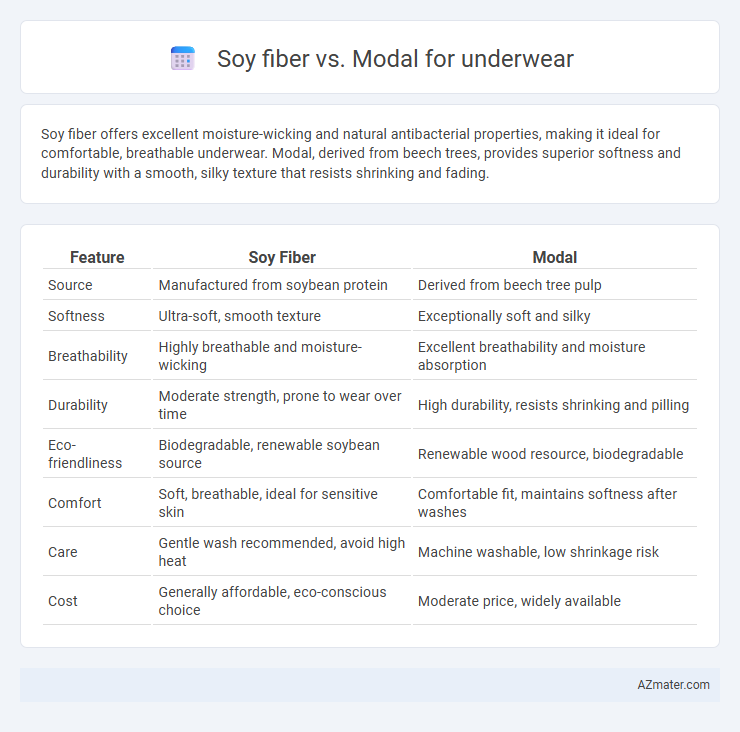Soy fiber offers excellent moisture-wicking and natural antibacterial properties, making it ideal for comfortable, breathable underwear. Modal, derived from beech trees, provides superior softness and durability with a smooth, silky texture that resists shrinking and fading.
Table of Comparison
| Feature | Soy Fiber | Modal |
|---|---|---|
| Source | Manufactured from soybean protein | Derived from beech tree pulp |
| Softness | Ultra-soft, smooth texture | Exceptionally soft and silky |
| Breathability | Highly breathable and moisture-wicking | Excellent breathability and moisture absorption |
| Durability | Moderate strength, prone to wear over time | High durability, resists shrinking and pilling |
| Eco-friendliness | Biodegradable, renewable soybean source | Renewable wood resource, biodegradable |
| Comfort | Soft, breathable, ideal for sensitive skin | Comfortable fit, maintains softness after washes |
| Care | Gentle wash recommended, avoid high heat | Machine washable, low shrinkage risk |
| Cost | Generally affordable, eco-conscious choice | Moderate price, widely available |
Introduction to Soy Fiber and Modal
Soy fiber, derived from soybean protein, offers natural softness, breathability, and moisture-wicking properties ideal for underwear. Modal, a semi-synthetic fiber made from beech tree pulp, is renowned for its smooth texture, durability, and excellent moisture absorption. Both fabrics provide comfort and sustainability, with soy fiber emphasizing eco-friendly production and Modal excelling in fabric resilience and drape.
What is Soy Fiber?
Soy fiber, derived from soybean protein through a natural chemical process, offers a sustainable and eco-friendly alternative for underwear fabrics. Known for its softness, moisture-wicking properties, and antimicrobial benefits, soy fiber enhances comfort and hygiene in intimate wear. Compared to modal, which is made from beech tree pulp and prized for its smooth texture and durability, soy fiber provides a plant-based option that balances breathability with environmental sustainability.
What is Modal?
Modal is a type of semi-synthetic fiber made from beech tree pulp, known for its exceptional softness, breathability, and moisture-wicking properties, making it ideal for underwear. Compared to soy fiber, modal offers superior durability, color retention, and a smooth texture that enhances comfort against the skin. Its eco-friendly production process uses less water and energy than conventional cotton, positioning modal as a sustainable yet luxurious fabric choice for intimate apparel.
Comfort and Softness Comparison
Soy fiber underwear offers exceptional softness due to its natural protein-based fibers, providing a smooth, silky feel that enhances comfort for sensitive skin. Modal fabric, made from beech tree cellulose, is highly breathable and moisture-wicking, delivering a cooler and drier sensation during wear. Both materials excel in softness, but soy fiber tends to be more hypoallergenic, while modal provides better stretch and durability in everyday use.
Moisture-Wicking and Breathability
Soy fiber offers excellent moisture-wicking properties due to its natural absorbency, keeping skin dry and comfortable throughout the day. Modal fabric, derived from beech tree pulp, provides superior breathability and softness, enhancing airflow and reducing heat buildup. When choosing underwear, soy fiber excels in moisture management while modal delivers optimal ventilation and a smooth texture.
Durability and Longevity
Soy fiber underwear offers moderate durability, benefiting from its natural protein structure that provides softness but wears down faster with frequent washing. Modal, derived from beech trees, excels in longevity due to its strong, smooth fibers that resist pilling and shrinking, maintaining shape and comfort over extended use. The enhanced tensile strength of modal fabric makes it a superior choice for underwear requiring lasting durability and consistent wear performance.
Eco-Friendliness and Sustainability
Soy fiber and modal are both eco-friendly options for underwear, with soy fiber derived from renewable soy protein waste and modal produced from sustainably harvested beech trees through a closed-loop process that recycles water and solvents. Soy fiber offers biodegradability and natural moisture-wicking properties, reducing environmental impact during use and disposal, while modal excels in durability and softness with lower energy consumption in manufacturing compared to traditional cotton. Choosing underwear made from either soy fiber or modal supports sustainable textile practices by minimizing chemical use, conserving natural resources, and promoting biodegradable end-of-life disposal.
Skin Sensitivity and Hypoallergenic Qualities
Soy fiber underwear offers exceptional softness and breathability, making it ideal for sensitive skin prone to irritation or allergies. Modal fabric provides excellent moisture-wicking and hypoallergenic properties, reducing the risk of skin reactions and maintaining comfort throughout the day. Both materials are sustainable choices with distinct benefits, but soy fiber ranks higher for natural skin-soothing qualities while modal excels in durability and moisture management.
Care and Maintenance Requirements
Soy fiber underwear offers gentle care with natural antibacterial properties that reduce odor, requiring mild washing at low temperatures to maintain softness and prevent fiber breakage. Modal fabric demands careful maintenance, including washing in cold water and avoiding high heat drying to preserve its smooth texture and prevent shrinkage. Both materials benefit from air drying and avoiding harsh detergents to extend the lifespan of the underwear.
Conclusion: Which is Better for Underwear?
Soy fiber offers exceptional softness and natural moisture-wicking properties, making it highly comfortable for underwear, while modal provides superior durability and resistance to shrinking or pilling. Modal's strong breathability and smooth texture make it ideal for long-lasting, everyday wear. For optimal underwear comfort and performance, modal is generally considered better due to its enhanced durability and moisture management.

Infographic: Soy fiber vs Modal for Underwear
 azmater.com
azmater.com